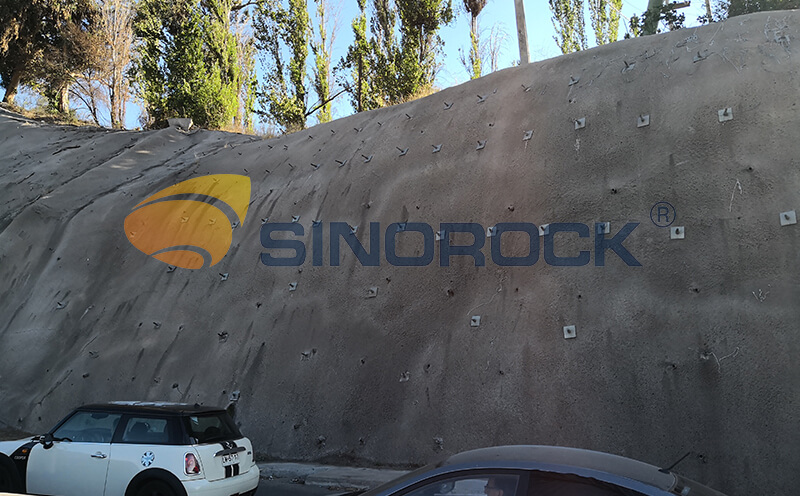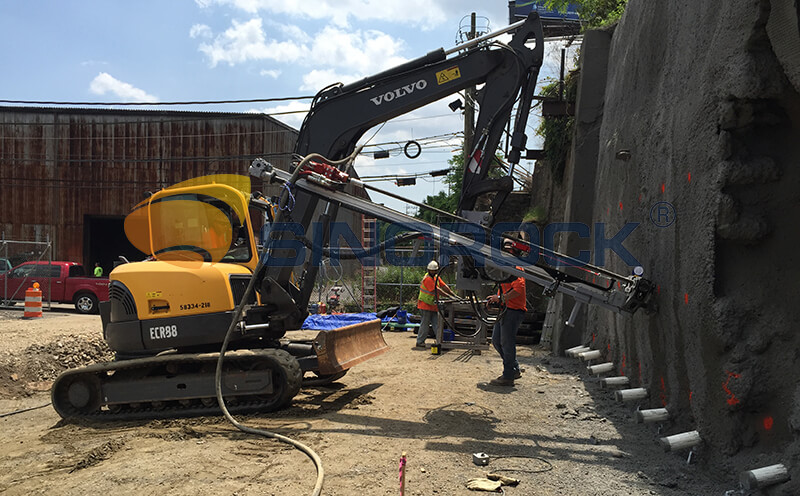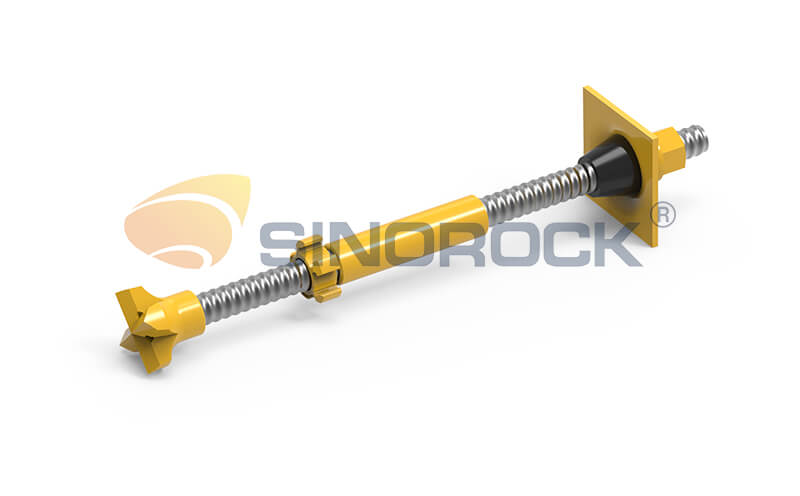4 Methods to Reinforce the Slope, Self-drilling Anchor Bolt Is the Best One
Time:2022-02-17From:sinorock View:
The slope is a very common terrain in highway and railway construction. During the construction process, it needs to be reinforced and supported by various methods to prevent collapse, falling rocks, uneven slope stress distribution, etc., and reduce safety. hidden danger. There are many methods for slope support. Today, Sinorock will introduce and analyze the advantages and disadvantages of the following four common slope support ways in detail.
Supporting the slope by the self-gravity of the retaining wall
Gravity retaining wall slope support is a relatively traditional and common slope support method. Its principle is to use the gravity of the slope body or the wall itself to resist the side pressure of the slope. Gravity retaining walls can be made of concrete, block stone, rubble, etc. Masonry or concrete can be directly poured on the slope surface, and are often used in highways, harbors, railways, mines, and other projects.
Advantages: easy to obtain materials and construction, low cost.
Disadvantages: large volume and weight, and it is difficult for weak geology to bear its weight.
Applicable situation: the height of the slope is not large, and the materials can be obtained locally.
Slope Support with Thin Wall Reinforced Concrete
That is, the thin-walled retaining wall belongs to the light retaining wall, which is divided into buttress type and cantilever type.
Advantages: simple structure, convenient construction, lightweight.
Disadvantages: It needs to consume a certain amount of steel and cement. If the slope height is relatively large, the amount of steel will be doubled and the cost will be higher.
Applicable situation: small slope height.

Ordinary bolt support (bolt shotcrete support)
Slope shotcrete support is a support method in which concrete and ordinary hollow bolts are combined to bear the slope weight together with the surrounding rock of the slope. Shotcrete support is a more complicated support method, and the construction process is also more complicated. Shotcrete anchor support is to drill holes on the slope first, then insert the bolts, and then use high pressure to drive the cement slurry into the drilled holes through the bolts to reinforce the surrounding rock mass together with the bolts. Although this support method can effectively limit the deformation of the surrounding rock, adjust the stress distribution of the rock mass, and prevent the rock mass from collapsing and falling, the construction process is too complicated and the efficiency is extremely low.
Advantages: strong adhesion, strong penetration, firm and reliable support.
Disadvantages: The construction process is complicated, the construction is difficult, and the efficiency is low.
Applicable situation: It can be used for temporary support of engineering slope.
Self-drilling anchor bolt for slope support
The self-drilling anchor bolt slope support is similar to the shotcrete support, but the efficiency is much higher than that of the shotcrete support. Most ordinary hollow bolts need to be drilled with drill pipes first, then the bolts are inserted, and then connected with the grouting machine for grouting. The self-drilling anchor bolts themselves are both drill pipes and bolts. After the rotary grouting adapter is connected to the grouting machine, grouting can be performed at the same time as drilling, realizing the integration of drilling, grouting, and anchoring functions, simplifying the construction process and shortening the construction time.


Advantages: convenient construction, strong anchoring force, and high efficiency.
Disadvantages: It is necessary to use a special drilling rig for self-drilling bolts for construction. There are few domestic manufacturers of self-drilling bolts, and there are also fewer self-drilling bolting rigs.
Applicable situation: It is suitable for soft to medium-hard rock formations, especially suitable for soft rock formations, easy to collapse holes, and difficult to form holes.
latest news
-

- What Are the Applications of SDA Bolts in Hydropower Stations?
- Time:2025-08-21From:This Site
- Learn how self-drilling anchor bolts enhance slope stability, tunnel support, and dam reinforcement in complex geological conditions at hydropower stations. Optimize hydropower projects with efficient, cost-effective, and eco-friendly solutions.
- View details
-

- Slope Stabilization with SDA Bolts: Benefits & Applications
- Time:2025-08-19From:This Site
- Discover how self-drilling anchor bolts (SDA bolts) provide superior slope stabilization for highways, railways, and tunnels. Learn their key benefits, installation process, and real-world applications in loose or collapsible soils.
- View details
-

- How Self-Drilling Rock Bolts Enhance Tunnel Support in Fractured Rock?
- Time:2025-08-15From:This Site
- Discover how self-drilling rock bolts enhance tunnel support in fractured rock. Learn their benefits, installation steps, and real-world applications for safe, efficient tunneling.
- View details
-

- Sinorock 2025 Quality Month | Strengthening Quality Foundations, Empowering Product Excellence
- Time:2025-08-13From:This Site
- Sinorock’s 2025 Quality Month, themed “Strengthening Quality Foundations, Empowering Product Excellence,” successfully concluded, reinforcing our commitment to superior product quality.
- View details
-

- Sinorock Safety Month 2025 | Everyone Speaks Safety, Everyone Can Respond
- Time:2025-07-03From:This Site
- Sinorock Safety Month 2025, centered on the theme "Everyone Speaks Safety, Everyone Can Respond - Spot Workplace Hazards," has wrapped up successfully!
- View details
-

- Quality Control: the Vital Factor of A SDA Bolt Factory
- Time:2025-01-09From:This Site
- Sinorock’s comprehensive quality control system, from supplier management to outgoing inspections, ensuring the highest standards for self-drilling anchor bolts in construction.
- View details
-

- Sinorock Invites You to Explore Proven Self-Drilling Anchor Bolt Solutions at bauma 2025
- Time:2025-03-07From:This Site
- From April 7–13, 2025, explore Sinorock’s Self-drilling anchor bolt solution at Booth C2.513/4 in Hall C2 of the Messe München Exhibition Center (Munich, Germany).
- View details
-
.jpg)
- SINOROCK to Attend EXPOMINA PERÚ 2024 in Lima, Peru
- Time:2024-08-10From:This Site
- Sinorock to Attend EXPOMINA PERÚ 2024 in Lima, Peru
- View details
-
.jpg)
- SINOROCK to Participate in MINING AND METALS CENTRAL ASIA 2024
- Time:2024-08-08From:This Site
- SINOROCK to Participate in MINING AND METALS CENTRAL ASIA 2024
- View details
 Download
Download 


